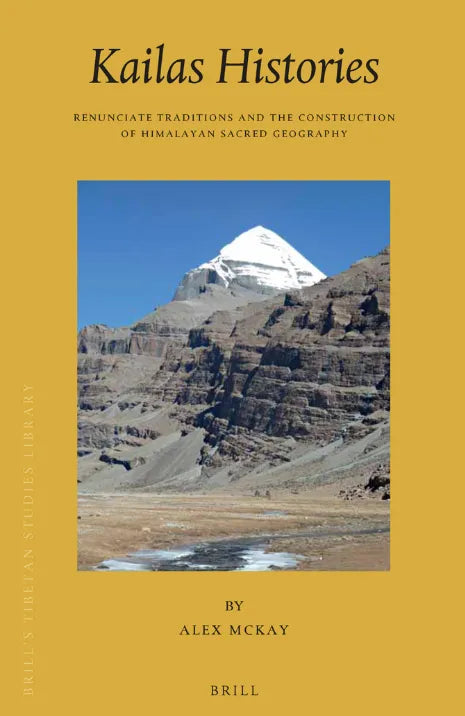
Interpretation of Mount Kailash (Part1)

Photographed by Kenro Izu, 2000
Collection of Rubin Museum

Late 18th century, British Museum collection

excerpt from "Kailash: A Journey to the Sacred Mountain of Tibet"
by Russell Johnson and Kerry Moran, 1989
Gondis is the holy land of monks
Mampang Lake is the paradise of fairies
(Traditional song from Ali region)

Painted by Nicholas Roerich (1874-1947)
1932, Roerich Museum Collection

"Panoramic View of Mount Kailash and Lake Manasarovar Sacred Site"
18th century, private collection
* A pilgrimage guide commissioned by the Zhigong Kagyu sect

Kailas

Taken from "The Bon religion of Tibet", 1995
In the ancient Tibetan scriptures "Biographies of the Successive Kings" unearthed in Dunhuang, it is written: "At the foot of the Disi Mountain, wild deer and wild mules thrive; by the side of the Mapang Lake, wild geese and wild ducks make their home," so sang the newly appointed nobles who submitted to the king. They used animals to refer to the Tibetan subjects (the followers). When they acted rebelliously, they were warned, "Wild deer and wild mules, do not act insolently, for the Disi Mountain will swallow you up; wild geese and wild ducks, do not act insolently, for the Mapang Lake will destroy you." Even before the introduction of Buddhism, the Gangdisi Mountain already held dual political and religious significance, with the reputation of being the "King of Sacred Mountains" resonating throughout Tibet. Although some scholars speculate that the term "Disi" (ཏི་སེ་) used to refer to Mount Kailash in Tibetan Buddhism is derived from Sanskrit; closer attention to the local cultural context reveals that "Disi" is actually a native Tibetan word, meaning "unique" or "treasure" (as seen in the Tibetan dictionaries). In the works of Bon practitioners, Kailas is an eternal and unchanging sacred space, the nine-layered Mount Meru of the spiritual realm, the cosmic center where the ancestors descended from the heavens.
Kailasa

Mid-19th century, in the collection of the British Museum
In the cultural context of the Himalayan region, "snow mountains" have always been a symbol of a hidden paradise, with the most famous being "Mount Kailash" (कैलास;ཀཻ་ལ་ཤ་). North of Mount Meru, there is a range of snow-capped mountains, among which lies a crystal-like snow mountain called Mount Kailash. According to Shaivite narratives, the poisonous main Shaivite deity resides in this cool area, while at the palace on the mountain top resides his wife, the Snow Mountain Goddess Parvati, his son Ganesha (the elephant-headed deity), and his mount Nandi (commonly depicted as a white bull in human form). For scholars of Shaivism, like the "Kailash" resembles the entire process of the creation, destruction, and regeneration of the worldly order. Similarly, in Jain scriptures, "Kailash" is seen as the place of enlightenment in the central space (मध्यलोक), where great sages and ancestors of the Jain tradition attained enlightenment. It is important to note that the concept of Jainism (རྒྱལ་བ་པ་) is not unfamiliar to Tibet, as the descriptions of "Kailash" from this tradition have been incorporated by Tibetan scholars in relation to the holy sites of Mount Kailash. However, the association of "Mount Kailash" with Mount Kailash is a product of collective imagination and historical development. People firmly believe that "Mount Kailash" must be found on Earth, and the unique and complex landscape of Mount Kailash has become the preferred choice for various religious traditions.
Mount Kailash

Excerpted from "Kailasa: A Pilgrimage to the Sacred Mountain of Tibet"
By Russell Johnson and Kerry Moran, 1989

Written by Alex McKai, 2015
In his book "Kailas Histories," scholar Alex McKay raised a question: why do so many religions choose to see Mount Kailash as the most important sacred mountain? A Western audience member responded, "Before I visited Mount Kailash, it was hard for me to imagine so many deities crowded at the summit from a rational perspective. But when I stood in front of this snow-capped mountain, all questions became meaningless, as it was a place that evoked deep contemplation and endless imagination." Derived from the term "Kang Rinpoche," meaning precious snow mountain in Tibetan, the relatively recent term "Mount Kailash" provides an explanation for the emergence of the "Kailash cultural sphere": the mountain is precious, thus imagination and reality are unified; it is viewed as precious, thus structure and imagery are harmonized; it is written as precious, thus memory and consensus are unified. We long to permanently dwell in grand landscapes.
Mandala of Mahavairocana

From the mid to late 15th century, stored in the Rubin Museum
As a religion originated in South Asia, Buddhism has absorbed the concept of "Kechara" and the uniquely Tibetan tradition of Tibetan Buddhism naturally also does not overlook the previous Tibetan descriptions of the Gangdise Mountains. Therefore, in the Buddhist context, Mount Kailash is not only the holy land where gods reside, but also the sacred object embodying the philosophical system. The description of Mount Meru in the texts has been transplanted to the specific space of Mount Kailash, where people believe that the victorious Vajrasattva and Vajravāraḥī reside on this snowy mountain. However, scholars such as Sakya Pandita (1182-1251) and Ngawang Drakpa (1348-1412) have pointed out that the sacred lake of the snow mountain mentioned in the scriptures is not Mount Kailash and Lake Manasarovar in Tibet; Sakya even raised several doubts in his "Discriminating the Three Vows" text. Nevertheless, as other traditions continue to empower Mount Kailash and Lake Manasarovar, the consensus that this snow mountain is the abode of Vajrasattva's "essence" and the hidden sacred city has taken shape in Tibet.
Arhat Stable

18th century, Ruben Museum collection
Snow-capped mountains and a sacred lake can be seen in the distance.

From "Kailash: A Pilgrimage to the Sacred Mountain of Tibet" by
